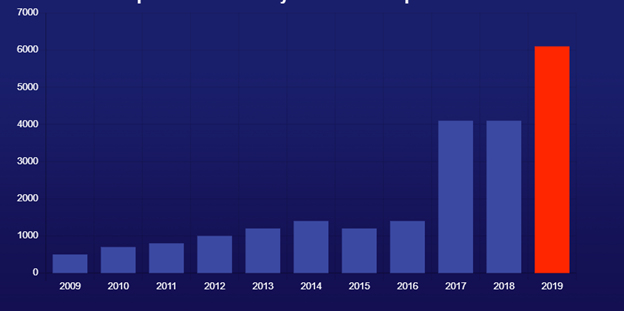Open source vulnerabilities have been on the rise in recent years, but 2019 was truly one for the record books with a spike of nearly 50% over the previous year.
According to the recently released State of Open Source Security Vulnerabilities report by the WhiteSource research team, the number of vulnerabilities jumped from 4,100 in 2018 to 6,100 in 2019.

In hopes of better understanding what is behind this rise in the number of open source vulnerabilities, what it tells us about the state of open source usage in modern software development, and even where we are likely headed in the years ahead, let’s take a look at the report’s findings for insights on the current state of open source security.
More Code, More Vulnerabilities
According to the research report, the primary driver behind the rise in open source vulnerabilities is a function of the growth of open source. There are now more open source projects, code and members of the community than ever before.
All of these good folks are working hard to not only write more code, often with the backing of large tech giants, but also to seek out vulnerabilities in the code that can put the users of their components at risk. The combination of more code being written and the number of eyeballs reviewing the code for those inevitable human mistakes, comes together to produce a larger number of vulnerabilities being reported.
The increase in the number of vulnerabilities in open source components will have a considerable impact on software development. In recent years, we have seen open source components playing a bigger role in how developers build their applications. Most estimates believe that open source components comprise between 60-80% of the codebase in most modern applications. When a vulnerability is reported in a popular project such as Apache Struts or the Linux kernel, then huge swaths of developers can quickly find their software in need of patching.
The Good, the Bad and the Bazaar
WhiteSource’s research revealed the reassuring news that over 85% of reported open source security vulnerabilities have a fix available.
One of the reasons for this improvement is the fact that more enterprises are dependent on open source components for their own software, so they are investing in making it more secure, via bug bounty programs, backing foundations that support open source security or backing the projects themselves.
However, even as the situation in the field appears to be improving, there is still a way to go.
The fact that many published open source vulnerabilities are not indexed in one central location adds complexity to this challenge for development teams attempting to stay on top of published open source security vulnerabilities. If proprietary software is still considered to be the classical Cathedral, well-organized information and support under one roof, then open source is very much the Bazaar.
The WhiteSource report found that only 84% of known open source vulnerabilities appear in the National Vulnerability Database (NVD). This means that information about another 16% of the known vulnerabilities is out there, spread out among a wide range of resources. These might be security advisories, bug trackers and a laundry list of other locations. While 45% of reported open source vulnerabilities that were not initially published on the NVD eventually end up there, that could take months since their publication on other resources.
The challenge for organizations is that they run the risk of using a vulnerable component unaware of the security updates, while hackers are scouring all resources, looking for vulnerabilities that could be their next meal ticket.
Given the evolving security challenges facing organizations, what does the future hold for open source security in the year ahead?
Our Predictions for 2020
The easiest prediction that we can provide is that 2020 will have even more reported open source vulnerabilities than were published in 2019. The only question is: How big it will be? Chances are that the count will be more significant due to recent advances making it easier than ever to report and an open source vulnerability.
This past year saw the launch of GitHub Security Lab which aims to help researchers, maintainers and users easily report an open source vulnerability and publish a verified fix in one centralized location. By simplifying the reporting and documentation process, GitHub has gone a long way in helping their users to protect their software with better quality reporting.
Key Takeaways
For many, the rise in the number of reported open source vulnerabilities might be concerning, making us confront the fact that we probably have plenty of them in our software right now. However, the situation is actually improving, and even heading in the right direction. When vulnerable open source components are reported, we get to track them and move quickly to remediate. Only once you know you have a problem can you begin to fix it.
Hopefully, the increase in security awareness will keep pushing for a stronger, more organized and better supported open source community that will be resilient in the face of even more vulnerabilities that are likely to show up in next year’s research report.





